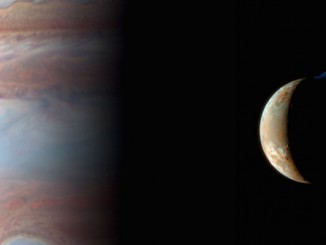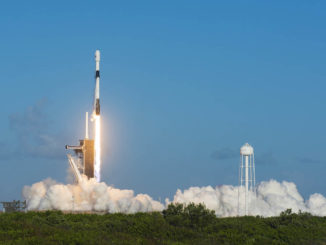
An Indian Polar Satellite Launch Vehicle placed Brazil’s Amazonia 1 satellite into orbit Sunday to begin a mission monitoring deforestation in the Amazon rainforest, then released 18 smaller spacecraft at a lower altitude, marking a successful start to India’s 2021 launch schedule that could see as many as seven orbital-class rocket missions.
The 144-foot-tall (44.4-meter) launch vehicle lifted off from the First Launch Pad at the Satish Dhawan Space Center at 11:54 p.m. EST Saturday (0454 GMT; 10:24 a.m. local time Sunday) and headed southeast from the spaceport on India’s east coast.
After arcing downrange over the Bay of Bengal, the rocket veered right on a southerly course to line up with the mission’s target orbit. The maneuver, called a dog-leg, ensured the PSLV did not fly over Sri Lanka and did not risk dropping debris on the populated island.
The PSLV took off on the power of its solid-fueled core stage and two strap-on solid rocket boosters, combining to produce up to 1.4 million pounds of thrust. The rocket dropped its two strap-on motors about a minute after liftoff, then the first stage motor burned out and jettisoned just shy of the two-minute mark of the mission.
A liquid-fueled second stage engine and a solid-burning third stage ignited in succession before giving way to the PSLV’s fourth stage to finish the job of placing the 19 satellites into orbit.
The two engines on the fourth stage, burning hydrazine fuel, burned more than eight minutes before deploying the 1,404-pound (637-kilogram) Amazonia 1 satellite into orbit.
Amazonia 1 is the first Earth observation satellite completely designed, integrated, tested, and operated by Brazil, according to INPE, a division of Brazil’s Ministry of Science, Technology, Innovation, and Communications. The PSLV aimed to deliver the Amazonia 1 satellite to a 467-mile-high (752-kilometer) sun-synchronous orbit with an inclination of about 98.5 degrees
In that type of orbit, Amazonia 1 will fly over different parts of the world at roughly the same time of day, allowing its imager to observe the environment under similar lighting conditions throughout the satellite’s four-year mission.
ISRO officials confirmed the rocket separated the Brazilian spacecraft into the correct orbit. Officials in the launch control center said Amazonia 1 extended its power-generating solar panels, and ground teams established contact with the new satellite after it arrived in space.
“In this mission, India and ISRO feel extremely proud and honored and happy to launch the first satellite designed, integrated, and operated by Brazil,” said K. Sivan, chairman of the Indian Space Research Organization. “My heartiest congratulations to the Brazilian team for this achievement. The satellite is in very good health, and solar panels are deployed, and it’s functioning very nicely. Let me congratulate and compliment the entire Brazilian team.”
Marcos Pontes, Brazil’s minister of science, technology, innovation, and communications, observed the launch from the Indian space center. In remarks after the launch, Pontes said it was a “very, very happy day.”
“We’ve been working on this satellite for many years, and this moment represents a very important (milestone),” Pontes said.
India’s PSLV rockets off the launch pad at the Satish Dhawan Space Center moments ago with Brazil’s Amazonia 1 Earth observation satellite.
Live coverage: https://t.co/2zPUPcWYRz pic.twitter.com/rAH02alr9q
— Spaceflight Now (@SpaceflightNow) February 28, 2021
“This satellite has a very important mission. First of all, it’s one more satellite to monitor the country, the Amazon, and other biomes in Brazil,” he said. “As well, it represents a new era of the Brazilian industry for satellites and development in Brazil. It brings a piece, the Multi-Mission Platform, that can be used for other satellites. So this is very important, and I couldn’t choose a better place to be than here in India.”
Pontes, a former astronaut, said the launch is an “important step” in Brazil’s relationship with India. He said he was speaking on behalf of Brazilian President Jair Bolsonaro.
“Congratulations on a beautiful launch, a beautiful rocket, and all the efforts that have been done here … We are going to work together as allies.”
INPE booked the launch on India’s PSLV through Spaceflight, a U.S. company that specializes in arranging rides to orbit for small satellites. Spaceflight says it purchased the entire capacity of the PSLV for Amazonia 1, the largest satellite it has contracted launch services for to date.
Spaceflight procured the launch from NewSpace India Ltd., a newly-established commercial arm of ISRO. It was the first commercial launch for NSIL.
“The deployment of Amazonia 1 will allow us to capture images and monitor the environment and agriculture throughout the Brazilian territory which will help us better understand the expansive terrestrial environment in the region,” said Adenilson Silva, an INPE engineer managing the Amazonia mission.
The Amazonia 1 satellite is the most advanced spacecraft ever built in Brazil, using the homemade Multi-Mission Platform, or MMP, bus. Although the platform uses parts acquired abroad, the program allows Brazil to gain experience in spacecraft manufacturing, testing, integration, propulsion, and deployment mechanisms, according to INPE.
“In addition to the technological achievements of the mission, it also represents the last step of MMP development,” Silva said in a statement.

The Amazonia 1 satellite carries a wide-angle optical imager with a resolution of 210 feet (64 meters). The imaging instrument will take pictures of an area spanning up to 528 miles (850 kilometers) wide, allowing the satellite to observe a wide swath of the planet on each orbit.
The satellite’s wide viewing area will allow it to revisit the same part of the world every five days, officials said. Amazonia 1 will also monitor agriculture in Brazil and other regions around the planet, INPE said.
Amazonia 1 will work in tandem with the CBERS 4 and CBERS 4A satellites developed in partnership between China and Brazil. On those missions, China built and launched the satellites, while Brazil provided instrument hardware.
The 18 smaller payloads that rode the PSLV into orbit include 12 tiny SpaceBEE satellites from Swarm Technologies. The small data relay nodes each weigh less than 2 pounds (1 kilogram). The “BEE” in SpaceBEE stands for Basic Electronic Element.
Swarm, headquartered in Silicon Valley, is developing a low-data-rate satellite communications fleet the company says could be used by connected cars, remote environmental sensors, industrial farming operations, transportation, smart meters, and for text messaging in rural areas outside the range of terrestrial networks.
Each of the SpaceBEEs is about the size of a slice of bread. The launch of 12 new satellites came a month after SpaceX launched 36 SpaceBEEs for Swarm on a rideshare mission that lifted off from Cape Canaveral, Florida.
There was a CubeSat named NanoConnect 2 developed by Mexican students at Universidad Nacional Autónoma de México, or UNAM, in Mexico City on the PSLV mission. NanoConnect 2 will test power, computer, communications, and mechanical satellite systems in the space environment. The PSLV also carried five Indian nanosatellites from academic institutions and the Indian military.
After releasing Amazonia 1 into its 467-mile-high orbit about 17 minutes after liftoff, the PSLV fourth stage reignited its thrusters for two burns to lower its altitude to 317 miles (511 kilometers) for separation of the other 18 payloads nearly two hours into the mission. The orbit-lowering maneuvers were designed to reduce the orbital lifetime of the smaller rideshare payloads, which will naturally re-enter the atmosphere from the effects of drag and burn up.
The shorter orbital life will help ensure the small satellites will not become a long-term source of space junk.

ISRO confirmed all 18 secondary payloads separated from the rocket as planned, wrapping up India’s first orbital launch of 2021.
In post-launch remarks, Sivan said ISRO’s “hands are full” this year.
The coronavirus pandemic interrupted India’s launch schedule last year. ISRO launched just two missions into orbit in 2020, after conducting five successful orbital launches in 2019.
Sivan said ISRO has seven launches of Indian rockets scheduled this year, plus six satellite missions. Indian officials also hope to launch an unpiloted test flight of the country’s Gaganyaan crew capsule in December, a precursor to an orbital mission with astronauts in the 2023 timeframe. The Gaganyaan program aims to make India the fourth country to put astronauts into orbit, following Russia, the United States, and China.
The work to prepare India’s space missions this year will occur under a “new normal” with health protocols to protect against the spread of COVID-19, Sivan said.
“We have not come out of the COVID pandemic,” he said. “I ensure that all this work has to happen with the quality norms, at the same time without violating the safety and security of my employees.”
Email the author.
Follow Stephen Clark on Twitter: @StephenClark1.



